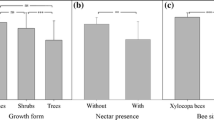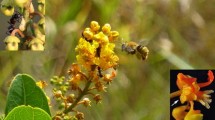Abstract
According to the distraction hypothesis, extrafloral nectaries (EFN) evolved under selection to entice ants away from floral nectaries, reducing ant-mediated damage to flowers and/or interference with pollinators. Predator-satiation, through production of nectar in either surplus flowers or EFN, provides an alternative mechanism for reducing the impact of ants as flower visitors. I tested these two hypotheses by experimentally adding EFN to flowering plants of the alpine wildflower, Polemonium viscosum, and by surveying the relationship between ant visitation and nectary number in nature. Plants of P. viscosum lack EFN and experience flower damage by ants of Formica neorufibarbus gelida. Ant behavior was compared on plants with five flowers and three experimental EFN and on controls with equal floral display, but no EFN. Addition of EFN increased flower visitation by ants. The effect of EFN on flower visitation did not depend on proximity of EFN to flowers or attractiveness of EFN to ants. Findings suggest that ants perceived patch quality on a whole plant basis, rather than responding to EFN and flowers as distinct nectar patches. Ant visitation did not keep pace with nectary number in nature. The relationship between ant visitation and nectary number per plant was weak and shallow as predicted under satiation. Ant foraging choices on experimental inflorescences showed that ants bypass flowers avoided by earlier ants, enhancing probability of escape via satiation. Results do not support the idea that EFN evolve to reduce flower visitation by ants, but show instead that nectar in surplus flowers can satiate ants and reduce their negative impacts on flower function and integrity.


Similar content being viewed by others
References
Apple JL, Feener DH (2001) Ant visitation of extrafloral nectaries of Passiflora: the effects of nectary attributes and ant behavior on patterns in facultative ant–plant mutualisms. Oecologia 127:409–416
Barton AM (1986) Spatial variation in the effect of ants on an extrafloral nectary plant. Ecology 67:495–504
Bentley BL (1977) Extrafloral nectaries and protection by pugnacious bodyguards. Ann Rev Ecol Syst 8:407–427
Bernstein RA (1976) The adaptive value of polymorphism in an alpine ant, Formica neorufibarbus gelida. Psyche 83:180–184
Billick I (2003) Worker demography in the ant Formica neorufibarbis. Ecol Entomol 28:139–144
Blüthgen N, Gottsberger G, Fiedler K (2004) Sugar and amino acid composition of ant-attended nectar and honeydew sources from an Australian rainforest. Austral Ecol 29:418–429
Brock VE, Riffenburgh RH (1960) Fish schooling: a possible factor in reducing predation. J du Conseil 25:307–317
Bronstein JL (2001) The exploitation of mutualisms. Ecol Lett 4:277–287
Carroll CR, Janzen DH (1973) Ecology of foraging by ants. Ann Rev Ecol Syst 4:231–257
Charnov EL (1976) Optimal foraging: the marginal value theorem. Theor Popul Biol 9:129–136
Dudley LS (2005) Niche partitioning in the Dioecious Willow, Salix glauca. PhD Thesis, University of Missouri, Columbia
Elias TS (1983) Extrafloral nectaries: their structure and distribution. In: Bentley B, Elias T (eds) The biology of nectaries. Columbia University Press, New York, pp174–203
Federle W, Maschwitz U, Fiala B, Riederer M, Holldobler B (1997) Slippery ant–plants and skilful climbers: selection and protection of specific ant partners by epicticular wax blooms in Macaranga (Euphorbiaceae). Oecologia 112:217–224
Galen C (1983) The effects of nectar thieving ants on seedset in floral scent morphs of Polemonium viscosum. Oikos 41:245–249
Galen C (1999) Flowers and enemies: predation by nectar-thieving ants in relation to variation in floral form of an alpine wildflower, Polemonium viscosum. Oikos 85:426–434
Galen C, Butchart B (2003) Ants in your plants: effects of nectar-thieves on pollen fertility and seed-siring capacity in the alpine wildflower, Polemonium viscosum. Oikos 101:521–528
Galen C, Cuba J (2001) Down the tube: pollinators, predators and the evolution of flower shape in the alpine skypilot, Polemonium viscosum. Evolution 55:1963–1971
Galen C, Kevan PG (1983) Scent and color, floral polymorphisms and pollination ecology in Polemonium viscosum Nutt. Am Midl Nat 104:281–289
Galen C, Zimmer KA, Newport ME (1987) Pollination in floral scent morphs of Polemonium viscosum: a mechanism for disruptive selection on flower size. Evolution 41:599–606
Ghazoul J (2001) Can floral repellents pre-empt potential ant-plant conflicts? Ecol Lett 4:295–299
Heenan PB (1999) Extrafloral nectaries in Elingamita johnsonii Imyrsinaceae. N Z J Bot 37:183–185
Inouye DW, Taylor OR (1979) A temperate region plant-ant-seed predator system: consequences of extra floral nectar secretion by Helianthella quinquenervis. Ecology 60:1–7
Josens RB, Farina WM, Roces F (1998) Nectar feeding by the ant Camponotus mus: intake rate and crop filling as a function of sucrose concentration. J Insect Phys 44:579–585
Keeler KH (1980) Distribution of plants with extrafloral nectaries in temperate communities. Am Midl Nat 104:274–280
Kelly D (1994) The evolutionary ecology of mast seeding. Trends Ecol Evol 9:465–470
Kerner A (1878) Flowers and their unbidden guests. C. Kegan Paul and Co, London
Knox RB, Kenrick J, Bernhardt P, Marginson R, Beresford G, Baker I, Baker HG (1985) Extrafloral nectaries as adaptations for bird pollination in Acacia terminalis. Am J Bot 72:1185–1196
Koptur S (1992) Extrafloral nectary mediated interactions between insects and plants. In: Bernays E (ed) Insect–plant interactions, vol IV. CRC Press, Boca Raton, pp 81–129
Lamb AE, Ollason JG (1994) Trail-laying and recruitment to sugary foods by foraging red wood-ants Formica aquilonia Yarrow (Hymenoptera: Formicidae). Behav Process 31:111–124
McDade LA, Kinsman S (1980) The impact of floral parasitism in two neotropical hummingbird-pollinated plant species. Evolution 34:944–958
Norment CJ (1988) The effect of nectar-thieving ants on the reproductive success of Frasera speciosa (Gentianaceae). Am Midl Nat 120:331–336
O’Dowd D (1979) Foliar nectar production and ant activity on a neotropical tree, Ochroma pyramidale. Oecologia 43:185–191
Puterbaugh MN (1998) The roles of ants as flower visitors: experimental analysis in three alpine plant species. Oikos 83:36–46
Rosensweig ML (2002) The distraction hypothesis depends on relatively cheap extrafloral nectaries. Evol Ecol Res 4:307–311
Rudgers JA (2004) Enemies of herbivores can shape plant traits: selection in a facultative ant–plant mutualism. Ecology 85:192–205
Rudgers JA, Gardener MC (2004) Extrafloral nectar as a resource mediating multi-species interactions in communities. Ecology 85:1495–1502
SAS Inst. Inc. (1996) SAS /STAT Software: changes and enhancements through Release 6.11
Schilman PE, Roces F (2003) Assessment of nectar flow rate and memory for patch quality in the ant Camponotus rufipes. Anim Behav 66:687–693
Wackers FL, Bonifay C (2004) How to be sweet? Extrafloral nectar allocation by Gossypium hirstum fits optimal defense theory predictions. Ecology 85:1512–1518
Wagner D (1997) The influence of ant nests on Acacia seed production, soil chemistry, and herbivory. J Ecol 85:83–94
Wagner D (2000) Pollen viability reduction as a potential cost of ant association for Acacia constricta (Fabaceae). Am J Bot 87:711–715
Wagner D, Kay A (2002) Do extrafloral nectaries distract ants from visiting flowers? An experimental test of an overlooked hypothesis. Evol Ecol Res 4:293–305
Waller DM (1993) How does mast-fruiting get started? Trends Ecol Evol 8:122–123
Wheeler GC, Wheeler J (1986) The ants of Nevada. Los Angeles County Musem of Natural History, Los Angeles
Wilmer PG, Stone GN (1997) How aggressive ant-guards assist seed-set in Acacia flowers. Nature (London) 388:165–167
Yu DW, Pierce NI (1998) A castration parasite of an ant plant mutualism. Proc R Soc Lond B 265:375–382
Acknowledgments
I thank E. Baack and L. Delph for helpful conversations and advice; A.Dona and J. Rudgers, and two anonymous reviewers provided useful comments on the manuscript. NSF Grant DEB-0316110 funded this research.
Author information
Authors and Affiliations
Corresponding author
Additional information
Communicated by Jacqui Shykoff
Rights and permissions
About this article
Cite this article
Galen, C. Catching ants with honey: an experimental test of distraction and satiation as alternative modes of escape from flower-damaging ants. Oecologia 144, 80–87 (2005). https://doi.org/10.1007/s00442-005-0042-3
Received:
Accepted:
Published:
Issue Date:
DOI: https://doi.org/10.1007/s00442-005-0042-3




